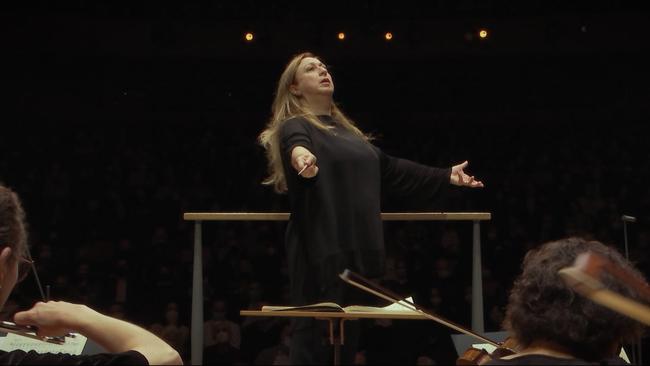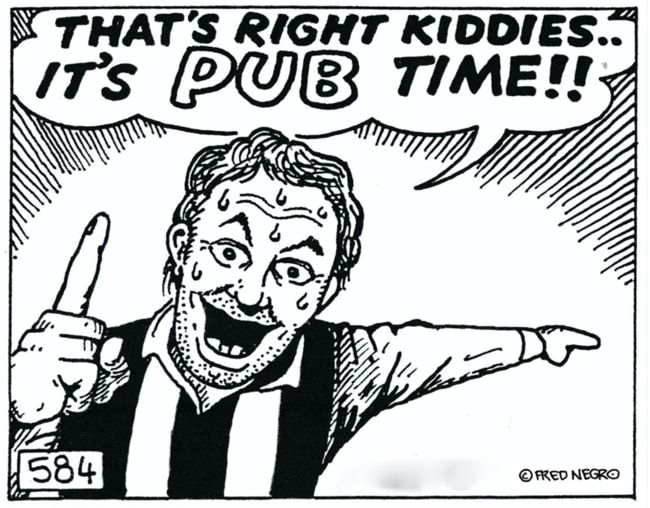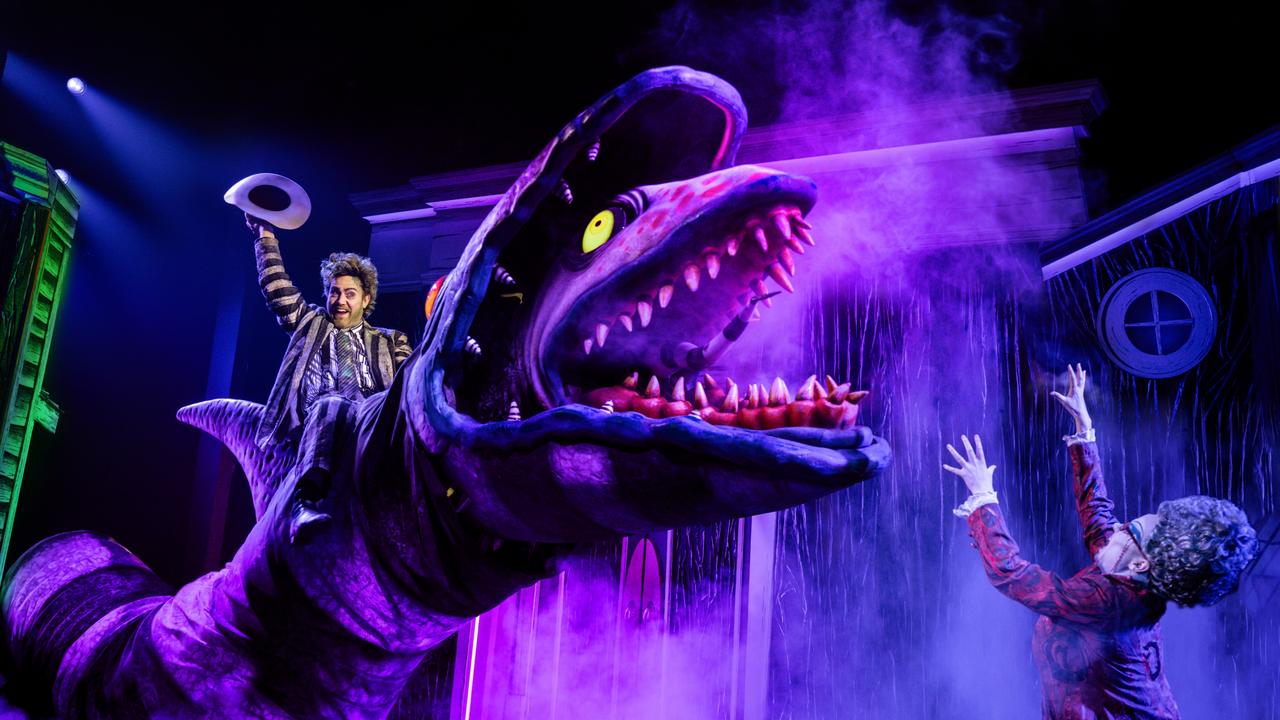Knowing The Score, Simone Young doco demands encore
This Australian maestro might be, to quote herself, a “workaholic, perfectionist, control freak”, as is Tar, but she is far more down to earth.

Knowing the Score (PG)
In cinemas
★★★★
Cate Blanchett is executive producer of Knowing The Score, an absorbing documentary about the glass ceiling-smashing Australian conductor Simone Young.
Young is not the conductor Blanchett worked with ahead of her Oscar-nominated performance in Tar, but the fictional American Lydia Tar and the real Sydneysider Simone Young have a lot in common.
Each is fluent in German, which is perhaps no surprise when one plans to wave the baton in Berlin and Vienna, and each was inspired by Leonard Bernstein.
In Young’s case, that inspiration was tangible. As a schoolgirl in 1974 she saw Bernstein conduct the New York Philharmonic Orchestra at the Sydney Opera House.
“I had never heard anything that sounded like this. I was just blown away …’’ Young recalls of Bernstein’s take on Tchaikovsky’s Symphony No. 6 in B Minor. Almost 25 years later she would conduct the same orchestra.
The most telling common point is that they are women striving to strike a chord in a male-dominated artistic milieu.
On this timely subject Young is serious yet humorous.
“What does being a woman have to do with conducting?’’ she asks with a smile. “My tits’’ – and here she waves her conducting hands over said body parts – “don’t get in the way.’’
This Australian maestro – “It is not maestra,’’ she notes – might be, to quote herself, a “workaholic, perfectionist, control freak”, as is Tar, but she is far more down to earth.
When Young, who grew up in the beachside Sydney suburb of Manly, conducted the Vienna State Opera in 1993, she was the first woman to do so. When she was appointed chief conductor of the Sydney Symphony Orchestra in 2020, she was the first woman – and only the third Australian – to take the role since the orchestra was founded in 1908.
This 90-minute documentary is written and directed by Janine Hosking, who has a diverse CV. Her previous music-based documentaries are The Eulogy (2018), centred on classical pianist Geoffrey Tozer and I’m Not Dead Yet (2011), about country music singer Chad Morgan.
It is the perfect film to watch after seeing Blanchett’s 10-star performance in Tar (for which she worked with another Australian conductor, Natalie Murray Beale) as it explores similar off-podium questions.

At the same time is has a tighter focus on the music and how it is brought to life.
Watching Young in full flight before an orchestra is spectacular.
Young is interviewed in recent time – towards the end she is at the podium for the July 2022 reopening of the Opera House Concert Hall – and in her younger days via file footage.
Her family and friends contribute, as do music critics and administrators. The most revealing snippets, though, come from the musicians with whom the maestro has worked.
She talks about the tension between “Us and Them”. She jokes on their behalf: “What do you call 100 conductors at the bottom of the ocean? A good start”.
In rehearsals she is direct with the musicians, more so than Tar. “Not too much muscle,’’ she orders after twice stopping a rehearsal of Brahms’s Symphony No. 1 in C Minor.
Not everyone likes this – some critics think she over-bosses the music – but when Spanish opera star Placido Domingo delivers his verdict, he perhaps speaks for the majority: “She is no gimmick. She is a true musician”.
Young compares conducting an orchestra with coaching a sports team. Yes, there are stars on the field but it is the coach who brings them together to “create something special”. She remembers her own appointment, in Germany, as assistant to Argentinian conductor Daniel Barenboim as “a bit like bowling to Alan Border”.
While this movie charts the peaks of Young’s career, it does not shy away from the valleys, including her 2002 dismissal as artistic director of Opera Australia.
And of course there are the far more intimidating shadows over any conductor’s career. Young says she doubts herself every time she walks onto the stage.
“One stands humbled and apprehensive,’’ she continues, speaking specifically of Mahler, “because there is a masterpiece in front of you.”
Young says she is often asked the “honest and reasonable question” of what a conductor does. “Can’t the musicians do it without you? They have the music in front of them.”
Truth be told, in a very recent past life I pondered the same question. Having seen Tar and Knowing The Score, I ponder no more.
Pub: The Movie (R18+)
In cinemas from February 15
Details: linktr.ee/pubthemovie
★★★½
At the centre of Pub: The Movie is St Kilda-based Fred Negro, a sixty-something musician and cartoonist who has been dubbed the unofficial mayor of that Melbourne suburb.
In one context, this R-rated documentary is the polar opposite of the other documentary I’ve reviewed this week, Knowing the Score, centred on Australian conductor Simone Young.
If Negro ever fronts a classical band, there’s a fair bet it will be called Mahler and the Motherf--kers.
If you think I exaggerate, his previous bands include The F--k F--ks, The Brady Bunch Lawnmower Massacre, The Band Who Shot Liberty Valance (“stupidest band ever’’, he notes) and, the best known, I Spit On Your Gravy.
“You’re not going to show this film to the cops, are you?” asks Paul Elliott, former manager of Gravy, and it’s a reasonable question.
The vice squad were part of the mix during the drug and alcohol-fueled Melbourne “punk rock explosion”, to quote Negro, of the ’80s and ’90s. Most of the action, musical and otherwise, happened in St Kilda pubs, including the still semi-famous Esplanade Hotel.
And this is where Fred Negro’s story shares something with Simone Young’s. It’s about the pursuit of art, at almost any cost. Different sorts of art, to be sure.
“Gidday, Fred Negro’s the name,’’ he says as this film opens. “Basically what I do is chronicle the history of ratbags in St Kilda.”
That is true, via Negro’s long-running comic strip, Pub, which has appeared in various journals, mainly street press. It started out with fictional characters but Negro soon inserted the real ratbags of Melbourne’s fringe music scene, several of whom are interviewed.
Well-known interviewees include Paul Stewart (ex Painters and Dockers), Greg Macainish (ex Skyhooks) and, from the younger generation, Tim Rogers, frontman of You Am I.
Later in the movie, Negro, on stage before a crowd, says, “This show may contain adult concepts, but I seriously doubt it.”
He is sort of right on both counts. Negro and his bandmates behaved like children daring to do adult things. They swore, a lot, and exposed themselves on stage. Negro notoriously had live sex with a roast chicken, or so it is said.
It’s the same in the comic strip. Negro recalls that when he sent in his first contribution, he was told “not to use the word c--t”. He refused and the strip still exists, though it has has at times felt the censor’s blue pencil.
All of this was gold to the now-defunct Melbourne tabloid Truth. Here’s a headline from the vault: I SPIT ON YOUR GRAVY! TORRID SEX WITH DOLLY’S CHOOKS!!

Whether this was what inspired Richard Branson’s Virgin Records to sign the band is a question best directed to him. In any event, it’s fair to say that the punk bands did not scale the musical heights.
“People came to see the show, to see what would happen on stage. I don’t think they cared about the music,’’ says one-time member of the Gravy train Sam Crassweller.
It all sounds grottily glamorous but there is a B-side. The surprisingly still-living former band members drink and smoke as they remember the wild days of drugs, booze and sex, but in quiter moments they reflect on the sadder moments.
Crassweller sheds tears as she talks about her heroin addiction at age 19. She adds, “The last time I counted I had 61 dead friends”. Negro’s adult daughter Millie, who appeared in the comic strip from the time of her birth, adds, “A lot of faces in Pub have disappeared”.
This 80-minute movie is directed and co-written by Andrew Leavold. His co-writer and film editor Benji Steane deftly blends live interviews with file footage and, of course, Pub strips.
This is a social history about a certain place, a certain time and the people who lived - and died - through it. I suspect anyone who was part of that scene will find it nostalgically fascinating.
And localised social histories are valuable, full stop. I like Pub: The Movie for this reason, even though it’s a social history I’m deeply relieved I was not part of.




To join the conversation, please log in. Don't have an account? Register
Join the conversation, you are commenting as Logout